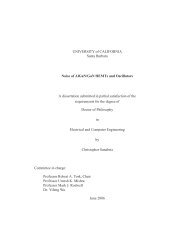No Slide Title
No Slide Title
No Slide Title
You also want an ePaper? Increase the reach of your titles
YUMPU automatically turns print PDFs into web optimized ePapers that Google loves.
Mutual Inductance<br />
L 1<br />
L 1<br />
© Robert York, 2006<br />
L m<br />
L m<br />
dI1 V1 = L1 ± Lm<br />
dt<br />
dI2<br />
dt<br />
V =± L<br />
dI<br />
+ L<br />
dt<br />
dI<br />
dt<br />
L 2<br />
L 2<br />
1 2<br />
2 m<br />
2<br />
I 1<br />
+<br />
V 1<br />
-<br />
I 1<br />
+<br />
V 1<br />
-<br />
L1<br />
dI<br />
2 Lm dt<br />
−<br />
L1<br />
dI<br />
2 Lm dt<br />
+<br />
-<br />
+<br />
-<br />
+<br />
-<br />
+<br />
-<br />
L2<br />
dI<br />
1 Lm dt<br />
L2<br />
1 Lm dt<br />
• Correct sign for mutual inductance found from Lenz’<br />
law and dot convention<br />
• Dot convention: current flowing into one dot will<br />
induce current flow out of second dot<br />
−<br />
dI<br />
+<br />
V 2<br />
-<br />
+<br />
V 2<br />
-<br />
I 2<br />
I 2
Transformers<br />
A transformer is just a special case where the mutual inductance is made as large as<br />
possible by allowing both coils to share the same flux<br />
This is usually achieved by winding them both on a common core of high permeability<br />
material (soft iron or ferrite materials)<br />
I 1<br />
+<br />
© Robert York, 2006<br />
V 1 V 2<br />
- -<br />
+<br />
I 2<br />
V = jωLI + jωL I<br />
1 1 1 m 2<br />
V = jωL I + jωL I<br />
2 m 1 2 2<br />
When there is no flux leakage, the mutual inductance is related to the primary and<br />
secondary inductances as<br />
L = LL<br />
m<br />
1 2<br />
For real transformers this can never be quite achieved, so we write<br />
Lm k LL 1 2 where 0 k 1<br />
= < < coefficient of coupling
I 1<br />
Ideal Transformer<br />
1:n<br />
+ +<br />
V 1 V 2<br />
-<br />
© Robert York, 2006<br />
-<br />
I 2<br />
If both coils share the same<br />
flux, then Farady’s law gives:<br />
As the permeability of the core<br />
increases, the relationship between<br />
the primary and secondary<br />
currents approaches a limiting<br />
value set by the turns ratio:<br />
V1 N1<br />
1<br />
= =<br />
V N n<br />
2 2<br />
I1 N2<br />
⇒ = n<br />
I N<br />
2 1<br />
These two relationships define an ideal transformer. This is a fictitous element (note that µ→∞<br />
implies infinite inductances so the impedance matrix is infinite) but a real transformer<br />
approximates this behavior.<br />
An idea transformer has the following useful property when one winding is terminated:<br />
I 1<br />
1:n<br />
+ +<br />
V 1<br />
-<br />
V 2<br />
-<br />
I 2<br />
Z L<br />
Z<br />
in<br />
V ( N / N ) V Z<br />
I ( N / N ) I n<br />
1 1 2 2<br />
= = =<br />
1 2 1 2<br />
L<br />
2
Transformer Equivalent Circuit<br />
Using the tee-equivalent for reciprocal networks, we find the following<br />
equivalent circuit for mutual inductances or transformers<br />
L1Lm © Robert York, 2006<br />
− L2−Lm Lm<br />
L ∝ N<br />
1 1<br />
L ∝ N = n L<br />
2<br />
2 2 1<br />
L = k LL = knL<br />
m<br />
1 2 1<br />
If desired, this circuit can be cascaded with an ideal 1:1 transformer to<br />
simulate the fact that a real transformer has electrically isolated ports
Alternative equivalent circuit<br />
The following is also an identical equivalent that uses an ideal transformer to<br />
explicitly incorporate the turns ratio and isolation between ports<br />
© Robert York, 2006<br />
L k<br />
2<br />
1 (1 ) −<br />
2<br />
kL1<br />
1:n<br />
ideal<br />
For good transformers, k is nearly 1, and this model also clearly shows why<br />
real transformers do not work at DC<br />
n<br />
=<br />
L<br />
L<br />
2<br />
m









